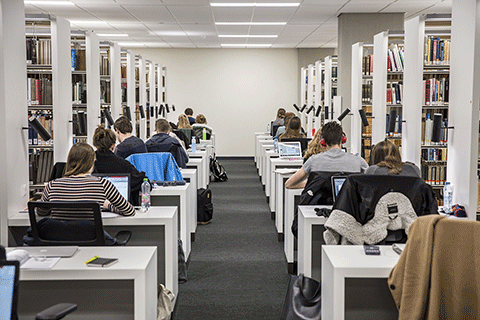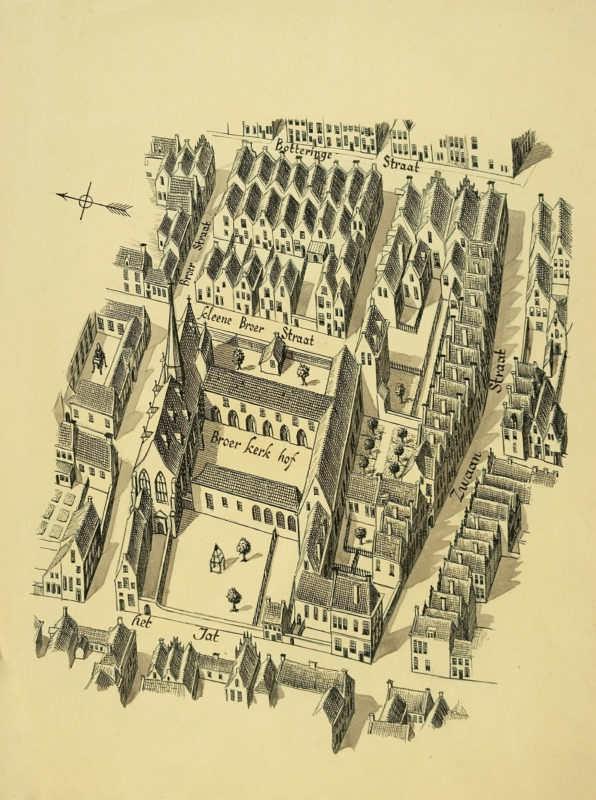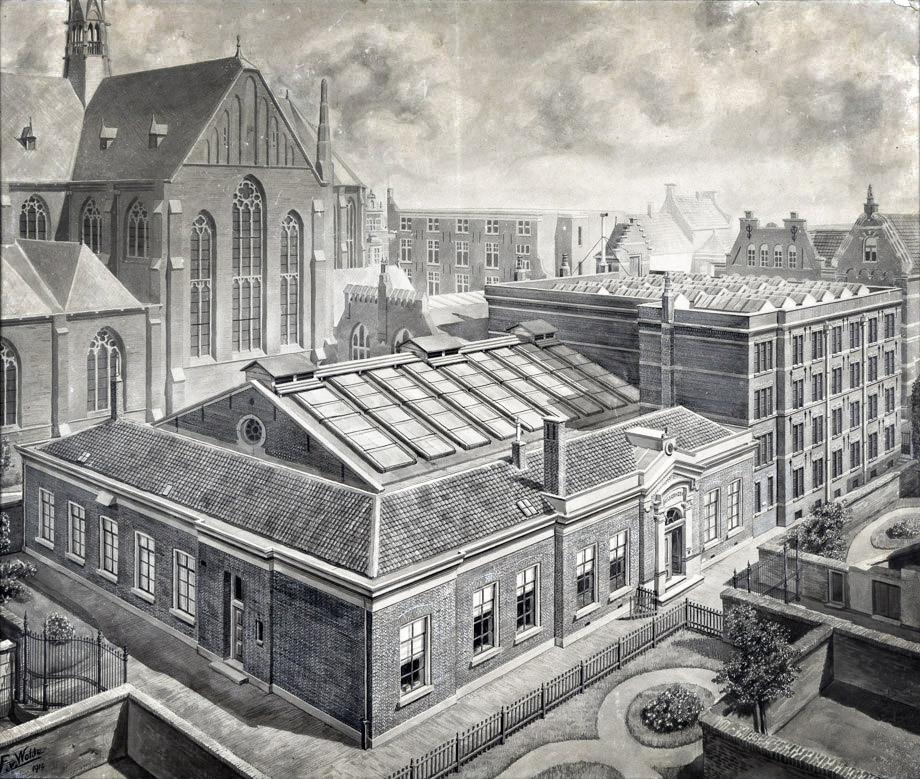
The UB’s 405th anniversary
Four centuries of constant complaining

A library in a cloister
See that low building with the six arches, just above where it says ‘Broerkerkhof’? That’s where, 405 years ago, the RUG built its very first university library. It used to be the sacristy in the Broerkerk, which until 1893 was located where the current UB is now. It’s the building with the pointy tower.
On February 28, 1615, the Groningen States decided ‘that the old library at the Broeren shall be turned into an anatomy lab downstairs and a library upstairs’. The university was given 600 guilders to buy books.
Groningen mayor Joachim Alting went to auctions and bookshops to buy the first 403 books, helped by Ubbo Emmius, the RUG’s very first rector magnificus. The books were organised across eight bookcases; three and a half were filled with theological literature and two and a half with legal texts. The other two cases held works on all the other sciences.
At first, only professors and custodians had a key. But the student population increased so much after 1655 that they too were given access. They were allowed in on Wednesday and Saturday, from one until three in the afternoon. However, they couldn’t borrow any of the library books; everything was chained to the shelves.

Falling stones
A library in a medieval building is all well and good, but as the years passed by, both the cloister and the church were falling into disrepair. Around 1829, the situation was becoming dangerous.
In order to reach the books, people had to go through the church choir and climb a set of steps to the cloister building behind it. This journey became increasingly perilous. Once stones started falling out of the walls, the UB closed down to create a new entrance, which went straight through the Latin school’s preceptor’s house in what is currently the Poststraat.
The library itself, in the meantime, was a mess. For centuries, professors had had their own keys. But ever since the books had been taken off their chains, around the year 1660, many of them had become lost. In fact, in 1833, the library closed for a year to inventory which books were actually still on the premises. The books themselves were now locked behind a gate.
The students, to their annoyance, still weren’t allowed to take any books home. One student compared the Utrecht library to the Groningen one: ‘They have one large, lovely room, perfectly decorated. Here, you can barely find the library behind the ugly Roman Church. It is peculiar in that it has a terrible entryway, leading to what looks like a menagerie. The small number of books are caged like animals, and can only be accessed by approaching the caretaker in a friendly way. And unlike in Leiden or Utrecht, you cannot take any of the books home.’
Above: J. G. Kramer, Photographer J.G. Kramer’s house and studio in front of the Roman Catholic Broerkerk (1886-1890); Collection Groninger Archives

State-of-the-art library
The building on the right of this drawing is beginning to look like the UB we have today. It’s the new book warehouse built in 1898.
After the old library was torn down, the medieval Broerkerk was also razed in 1895. Just like the library, it was in a terrible state. It was replaced by the slightly smaller Martinuskerk. This led to possibilities for the UB.
By tearing down the eastern wing of the library and using a vacant lot in the Poststraat, room was created for a new book storage building: 640 bookcases, with a total shelf length of 4,400 metres.
This building, too, had grate floors, which meant visitors had to wear sturdy shoes. And if anyone dropped a pencil, they would likely find it again four floors down.
Was the building an improvement? Not really: it was leaky, still way too small, and climate control was a mess. In 1900, the boilerman was found dead in the heating room, poisoned by the carbon monoxide fumes.
1914 brought radical change. The entire library was demolished, and only the warehouse remained standing. Unfortunately, the new building was too small.
Above: Pen drawing F. van Wolde, Collection Groninger Archives

State-of-the-art warehouse
The building on the right of this drawing is beginning to look like the UB we have today. It’s the new book warehouse built in 1898.
After the old library was torn down, the medieval Broerkerk was also razed in 1895. Just like the library, it was in a terrible state. It was replaced by the slightly smaller Martinuskerk. This led to possibilities for the UB.
By tearing down the eastern wing of the library and using a vacant lot in the Poststraat, room was created for a new book storage building: 640 bookcases, with a total shelf length of 4,400 metres.
This building, too, had grate floors, which meant visitors had to wear sturdy shoes. And if anyone dropped a pencil, they would likely find it again four floors down.
Was the building an improvement? Not really: it was leaky, still way too small, and climate control was a mess. In 1900, the boilerman was found dead in the heating room, poisoned by the carbon monoxide fumes.
1914 brought radical change. The entire library was demolished, and only the warehouse remained standing. Unfortunately, the new building was too small.

Reading room: The 1919 library
Go take a look at the University Museum, in the Oude Kijk in ‘t Jatstraat 7A. With your student ID, you get in for free.
Visit the big room upstairs, currently housing the exhibition The Dead Zoo. You are now in what used to be the reading room of the 1919 university library.
The room still has the same double doors, and the bookcases that used to be filled to the brim with books still line the walls. If you go through the wooden door on your left, you enter what used to be the ‘legal reading room’. It was an extra room that was furnished just for lawyers in 1932. They weren’t particularly appreciative of it, though. The law professors refused to use the room, since they didn’t like the fact that the board of custodians was in charge of the books and not them.
The new space was supposed to add a little breathing room. The building may have had two floors and more space than the previous library, but it was still too small.
The entrance was still in the back. If you walk around the back of the current UB, you can still see it.

The new UB: Sit-in
Let’s fast forward to 1984. This was the year it was decided that even the new, new UB had to make way for a modern building. But the new building could only be constructed if the Catholic church in the Broerstraat was torn down.
The university had seen its student population grow from just a thousand after the Second World War to approximately 20,000 in the eighties. The new UB would have room for 2.5 million books and 1,600 study spots.
Not everyone was happy with the plans, however. The demolition was met with fierce protests and there were even plans to preserve the church and house the library there, like they did with the church bookshops in Maastricht and Zwolle.
All these plans were rejected, though. They were deemed ‘unrealistic’ and ‘unfeasible’.
Photo Elmer Spaargaren

UB demolition
So the fate of the church was decided. It did mean, however, that countless Calvinist professors who’d been buried in the Academy church had to be reburied in a Roman Catholic cemetery.
The construction site presented other, unexpected opportunities, as the excavators brought up more human bones. Medical students would sneak into the site at night in an effort to pilfer human skulls.

What’s next?
The latest iteration of the library opened in 1986. This UB offered electrical typewriters, where students could type their handwritten essays. It also had a handful of primitive computers, which weren’t even connected to the internet, since it didn’t yet exist.
In 2014, this library, too, needed a facelift. More study spots – there are currently 2,100 – room for groups of students to get together, fewer books on the floor. The UB even closed for five weeks to allow the builders to get a move on.
Is the UB finally perfect?
Well… The warehouse under the library is getting too small, and the climate control is still a mess: students are either too cold or too warm. Students are complaining about everything. They’re annoyed by other students sleeping in the library, or by the noise of the people sitting next to them. Not that it stops them from coming. Last year alone, the UB had 2.5 million visitors.
Photo above by Pepijn van den Broeke
The UB is celebrating its anniversary on Thursday 27 February with the UBstairs festival. On Friday 6 March there’s an open house.
Sources used for this article:
Klaas van Berkel, De universiteit van het Noorden. Vier eeuwen academisch leven in Groningen, deel I en II ( Hilversum, 2014, 2017).
Gerda C. Huisman, The university library of Groningen. Four hundred years of history in four buildings, forty collections and infinite pictures (Groningen, 2016).

